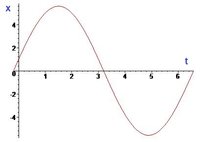… I understand why they … use [cosine] instead of [sine] since the particle start at x=1
… I would assume that a=1 since … the particle starts from rest …
Hi katsicum. I'm not sure what "starts at rest" means, in this exercise. Your statements above lead me to wonder if you're thinking in terms of the graph of y=cos(x). In this exercise, the particle is oscillating on the x-axis, as a function of
time.
Were we to look at the function's graph, the x-axis would be vertical and the t-axis would be horizontal.
We know the amplitude must be greater than 1 because the particle oscillates more than 5 units away from the Origin. We can also use the given form, to see that a cannot be 1. Set x=1 and t=0.
1 = a · cos(n·0 + α)
1 = a · cos(α)
a = 1/cos(α)
So, α would need to be 0, for a to be 1, but if α were 0 there would be no phase shift, and that leads to a contradiction because x is not at its maximum distance from the Origin when t is 0.
Using the given value of the period (6.7758, rounded), I'm thinking the graph looks something like this (because symmetry indicates a maximum must occur halfway between t=1 and t=2):

No immediate ideas occurred to me about why the period may be expressed in terms of arccos(3/5), but I didn't experiment with the algebra part much. I posted this information because I wanted you to have a better sense of what the function represents, as well as showing a graph.
PS: To form that graph, my value of a is negative. The amplitude is |a|.
?



